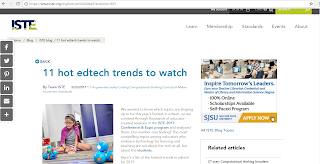Blog Post 8
Adaptive technologies are any devices used to assist students with disabilities in the classroom. These devices are specific to each students needs so they can have an equal learning opportunity within the classroom. For example, the podcast lists that students with vision problems can have a device that magnifies text so the student can see more clearly. My grandma is blind and has to use one of the magnifying devices in order to read. There are devices for visually impaired students that have audio capabilities so that the student can still have the information delivered to them. For physically disabled students there are other tools such as joysticks that the student can use as opposed to using a mouse pad in order to make operating the device simpler. The only challenge I see in using adaptive technologies in my classroom is ensuring that I properly know how to use and operate the device so I can help my student understand how to use it. Another issue could be if the device stopped working or my student forgot to bring the device in, figuring out a way to help this student keep up with the rest of the class even without the adaptive technology at hand.
Bloom's Taxonomy was created to place emphasis on higher forms of critical thinking and understanding rather than solely memorizing information. You could implement each level of Bloom's Taxonomy into PowerPoint to support student learning. At the first level you have "creating". You could use PowerPoint to create a table where students had to sort certain things into the section they belong to(Ex: elementary students could sort letters into a vowel or consonant section) . The next level, "Evaluating", could be used in PowerPoint by dedicating a slide to interpreting and explaining something such as the theme in a story students are reading. The next level, "Analyzing" can be used in PowerPoint by having different slides and sections that break down a stories plot following the story pyramid. "Applying" can be used in PowerPoint by having students make predictions of what they believe will happen in the story and displaying their ideas onto the PowerPoint for further discussion. You can demonstrate the next level, "Understanding" by listing out conflicts in the story on PowerPoint slides and summarizing the problems for further understanding. Finally, the last level, "Remembering" can be used in PowerPoint to retell portions of the story so students can have a recap of what happened in the story before reading the next chapter of the story.
This website describes different, trending ways technology can be implemented to meet teaching standards. https://www.iste.org/explore/articleDetail?articleid=865

Comments
Post a Comment